
CHAPTER 3 (PART 3)
NON-FUNCTIONAL CHORDS
Passing Chords
Passing chords are formed by the stepwise movement of one or more voices from a harmony note in one chord to form an intermediate chord or chords on the way to becoming a harmony note in another chord. The stepwise movement may be a filling in by one note or may be in multiple steps. If the filling in is by multiple steps then I will refer to this as a linear progression. (See Chapter 4.) One or more voices may be involved in similar or contrary motion. This type of chord has its origins in 16th century polyphony. See the Voice Leading Appendix: Arpeggiation and Passing Notes for more details. The reason for giving these chords a special name is not because they have a special significance but because they are capable of being confused with genuine functional chords. In reality, they arise out of voice leading movements just as other surface voice leading patterns do.
For a chord to be a passing chord it must normally be made up solely of notes retained from the preceding chord plus linear moving notes. The one exemption to this is that chromatic auxiliary notes are sometimes used in addition to the passing notes. This is because of the way that voice leading patterns can be combined. See Voice Leading Patterns Combined.
The passing chords so formed are thus non-functional and the surrounding chords on which the movement starts and ends are functional chords. Passing chords are used in both static and dynamic harmony.
The passing chord is named by analogy with the passing note. The following example contains a passing note marked with a "P":
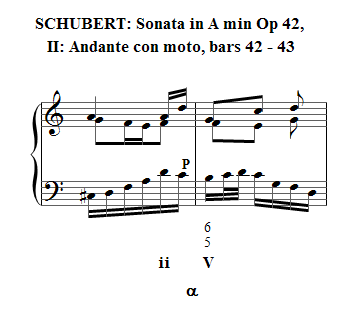
The passing note fills in the gap between notes of adjacent chords. It sounds whilst at least one note of the proceeding chord is retained. The short duration and nature of the passing note does not create a feeling of a change of harmony. The passing note usually forms a discord with other notes of the chord, as it does here. Note: I've shown chord ii in lower case letters to highlight the fact that it is a minor chord.
The passing chord is an extension of the passing note such that the duration of the passing note(s) and the way the note(s) sound, in conjunction with other notes of the chord, creates a sense of a change in harmony. Using the analytical symbols introduced earlier, the following harmonic outlines indicate some of the possibilities within the diatonic major scale:
.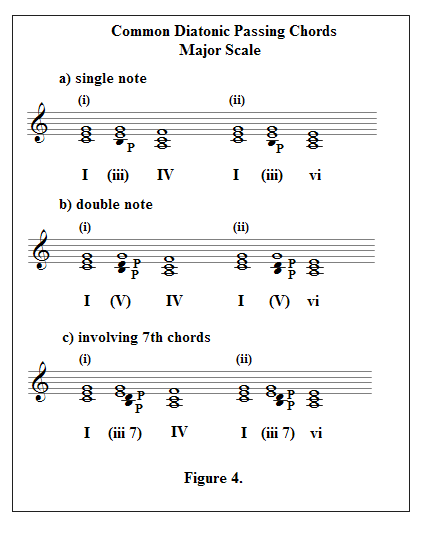
All the passing chords in the figure above are made up of two types of notes:
1. notes which are retained from the preceding chord (shown here as repeated white note heads) and
2. notes that take part in the stepwise movement (shown as black note heads annotated as "P")
Normally, if other notes are involved, the chord is not a passing chord. The one exemption to this is that chromatic auxiliary notes are sometimes used. These are introduced below. The curved brackets are used to indicate that the chords within them are passing chords. The lower case letters indicate that the chord is minor.
The examples moving from chord I to chord IV are common in both static and dynamic harmony and the examples moving form chord I to chord VI are common in dynamic harmony, in which case the progression is a β (beta) chord progression.
All the examples above start with chord I. However, the patterns may be transposed so that they start on other scale steps. For example, I ( iii ) IV could be transposed to ii ( IV ) V etc. It is not the actual scale steps involved that matter but the succession of scale steps. Similar patterns may also be derived for the minor key.
The following is an example of a) (i):
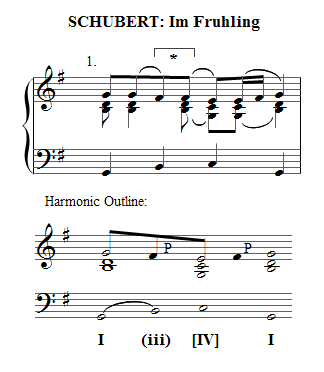
The white note heads indicate notes from functional chords and the black note heads indicate the passing notes involved in voice leading. The note combination highlighted by an * appears at first sight to be a chord iii in root position. However, the chord iii arises as a result of a passing note in the melody between chord I and chord IV. The F# is a stepwise filling in note between the G in chord I and the E in chord IV. The bass note B arises as an arpeggiation of the G major chord in the bass. As the chord iii is the result of a passing note and an arpeggiation, it will be referred to as a passing chord. The chord iii is thus the result of a voice leading movement rather than an harmonic movement. As this is a passing chord I've shown the iii in round brackets in this outline. I've shown the bass arpeggiation with a slur to show the two notes belong to the same structural chord. I've shown the descending passing note connected to the notes it fills in between with stems and a beam to highlight this passing motion because of its particular interest here. In this example, I've also followed the convention that I will follow in the full analysis chapter, that is that I have not shown the notes repeated form the preceding chord as new white notes in the passing chord. The assumption is that where these notes do not move they are still in force whilst the bass arpeggiates and the melody moves to the passing note. The ascending passing note between E and G, I've just shown as "P". This descending passing note pattern also occurs frequently with the passing note in the bass.
In this example, it is fairly easy to see the voice leading nature of the passing chord. However, it is not always so easy to establish which chords in a progression arise from voice leading and which are harmonic. Chords that at first sight appear to be functional may arise as the result of arpeggios, auxiliary notes, passing notes or appoggiaturas. For the harmony and syntactic structures to be correctly understood it is necessary to correctly identify and separate these non-functional chords from the underlying progression.
The following is an example of b) (ii) This example has a slower harmonic rhythm:
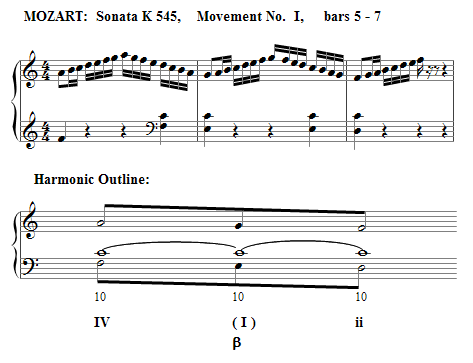
So far, we have only considered diatonic passing chords. However, the number of possibilities for chromatic passing notes is much greater. Any two notes separated by a tone in two successive functional chords can be elaborated by a stepwise chromatic filling in note. For example, C# can fill in the gap between C and D. Chromatic passing notes are even possible between two notes a minor third apart. For example, the space between the descending C to A interval, in C major, can be filled in by a B-flat in place of the diatonic B-natural.
When you consider that these chromatic notes can be combined in many ways, the number of possibilities is enormous. The resulting chromatic harmonies add variety and interest to the underlying diatonic harmonies but do not usually imply a change in key. The following table shows single voice only movements:
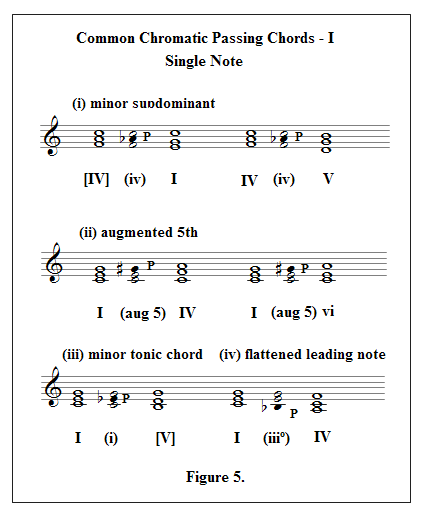
The following is an example of (ii). The augmented 5th chord arises from the filling in of the interval between chord I and chord IV:
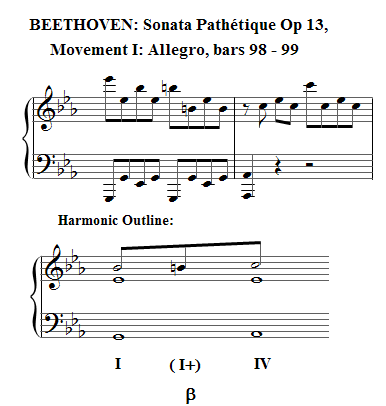
Note: There is a further description of the passing note and passing chords in the Voice Leading Appendix.
The Full book will contain further examples

